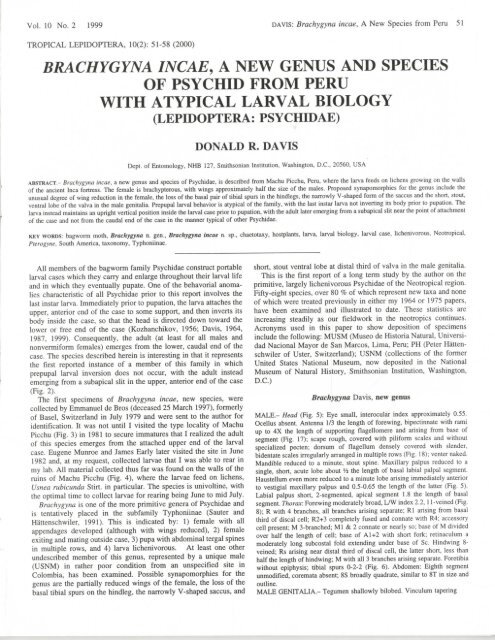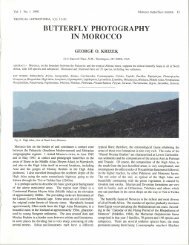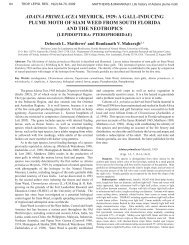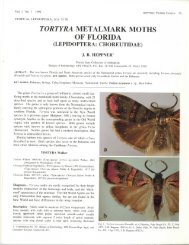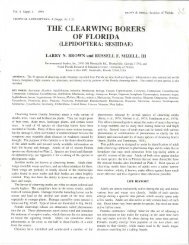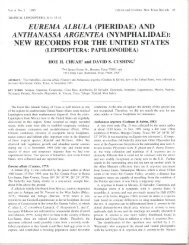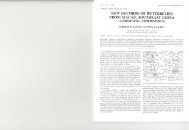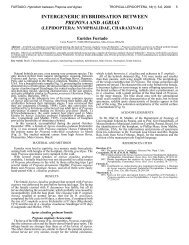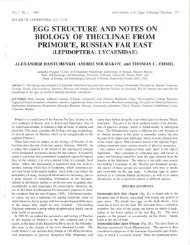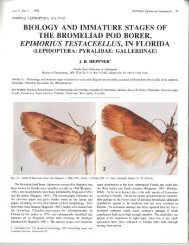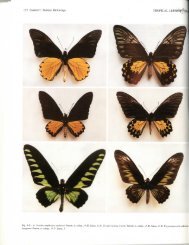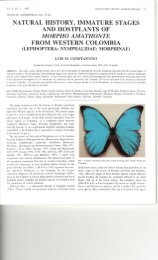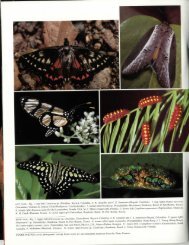brachygyna incae, a new genus and species of psychid from peru ...
brachygyna incae, a new genus and species of psychid from peru ...
brachygyna incae, a new genus and species of psychid from peru ...
You also want an ePaper? Increase the reach of your titles
YUMPU automatically turns print PDFs into web optimized ePapers that Google loves.
Vol. 10 No. 2 1999 DAVIS: Brachygyna <strong>incae</strong>, A New Species <strong>from</strong> Peru 51<br />
TROPICAL LEPIDOPTERA, 10(2): 51-58 (2000)<br />
BRACHYGYNA INCAE, A NEW GENUS AND SPECIES<br />
OF PSYCHID FROM PERU<br />
WITH ATYPICAL LARVAL BIOLOGY<br />
(LEPIDOPTERA: PSYCHIDAE)<br />
DONALD R. DAVIS<br />
Dept. <strong>of</strong> Entomology, NHB 127, Smithsonian Institution, Washington, D.C, 20560, USA<br />
ABSTRACT- Brachygyna <strong>incae</strong>, a <strong>new</strong> <strong>genus</strong> <strong>and</strong> <strong>species</strong> <strong>of</strong> Psychidae, is described <strong>from</strong> Machu Picchu, Peru, where the larva feeds on lichens growing on the walls<br />
<strong>of</strong> the ancient Inca fortress. The female is brachypterous, with wings approximately half the size <strong>of</strong> the males. Proposed synapomorphies for the <strong>genus</strong> include the<br />
unusual degree <strong>of</strong> wing reduction in the female, the loss <strong>of</strong> the basal pair <strong>of</strong> tibial spurs in the hindlegs, the narrowly V-shaped form <strong>of</strong> the saccus <strong>and</strong> the short, stout,<br />
ventral lobe <strong>of</strong> the valva in the male genitalia. Prepupal larval behavior is atypical <strong>of</strong> the family, with the last instar larva not inverting its body prior to pupation. The<br />
larva instead maintains an upright vertical position inside the larval case prior to pupation, with the adult later emerging <strong>from</strong> a subapical slit near the point <strong>of</strong> attachment<br />
<strong>of</strong> the case <strong>and</strong> not <strong>from</strong> the caudal end <strong>of</strong> the case in the manner typical <strong>of</strong> other Psychidae.<br />
KEY WORDS: bagworm moth, Brachygyna n. gen., Brachygyna <strong>incae</strong> n. sp., chaetotaxy, hostplants, larva, larval biology, larval case, lichenivorous, Neotropical,<br />
Pterogyne, South America, taxonomy, Typhoniinae.<br />
All members <strong>of</strong> the bagworm family Psychidae construct portable<br />
larval cases which they carry <strong>and</strong> enlarge throughout their larval life<br />
<strong>and</strong> in which they eventually pupate. One <strong>of</strong> the behavorial anomalies<br />
characteristic <strong>of</strong> all Psychidae prior to this report involves the<br />
last instar larva. Immediately prior to pupation, the larva attaches the<br />
upper, anterior end <strong>of</strong> the case to some support, <strong>and</strong> then inverts its<br />
body inside the case, so that the head is directed down toward the<br />
lower or free end <strong>of</strong> the case (Kozhanchikov, 1956; Davis, 1964,<br />
1987, 1999). Consequently, the adult (at least for all males <strong>and</strong><br />
nonvermiform females) emerges <strong>from</strong> the lower, caudal end <strong>of</strong> the<br />
case. The <strong>species</strong> described herein is interesting in that it represents<br />
the first reported instance <strong>of</strong> a member <strong>of</strong> this family in which<br />
prepupal larval inversion does not occur, with the adult instead<br />
emerging <strong>from</strong> a subapical slit in the upper, anterior end <strong>of</strong> the case<br />
(Fig. 2).<br />
The first specimens <strong>of</strong> Brachygyna <strong>incae</strong>, <strong>new</strong> <strong>species</strong>, were<br />
collected by Emmanuel de Bros (deceased 25 March 1997), formerly<br />
<strong>of</strong> Basel, Switzerl<strong>and</strong> in July 1979 <strong>and</strong> were sent to the author for<br />
identification. It was not until I visited the type locality <strong>of</strong> Machu<br />
Picchu (Fig. 3) in 1981 to secure immatures that I realized the adult<br />
<strong>of</strong> this <strong>species</strong> emerges <strong>from</strong> the attached upper end <strong>of</strong> the larval<br />
case. Eugene Munroe <strong>and</strong> James Early later visited the site in June<br />
1982 <strong>and</strong>, at my request, collected larvae that I was able to rear in<br />
my lab. All material collected thus far was found on the walls <strong>of</strong> the<br />
ruins <strong>of</strong> Machu Picchu (Fig. 4), where the larvae feed on lichens,<br />
Usnea mbicunda Stirt. in particular. The <strong>species</strong> is univoltine, with<br />
the optimal time to collect larvae for rearing being June to mid July.<br />
Brachygyna is one <strong>of</strong> the more primitive genera <strong>of</strong> Psychidae <strong>and</strong><br />
is tentatively placed in the subfamily Typhoniinae (Sauter <strong>and</strong><br />
Hattenschwiler, 1991). This is indicated by: 1) female with all<br />
appendages developed (although with wings reduced), 2) female<br />
exiting <strong>and</strong> mating outside case, 3) pupa with abdominal tergal spines<br />
in multiple rows, <strong>and</strong> 4) larva lichenivorous. At least one other<br />
undescribed member <strong>of</strong> this <strong>genus</strong>, represented by a unique male<br />
(USNM) in rather poor condition <strong>from</strong> an unspecified site in<br />
Colombia, has been examined. Possible synapomorphies for the<br />
<strong>genus</strong> are the partially reduced wings <strong>of</strong> the female, the loss <strong>of</strong> the<br />
basal tibial spurs on the hindleg, the narrowly V-shaped saccus, <strong>and</strong><br />
short, stout ventral lobe at distal third <strong>of</strong> valva in the male genitalia.<br />
This is the first report <strong>of</strong> a long term study by the author on the<br />
primitive, largely lichenivorous Psychidae <strong>of</strong> the Neotropical region.<br />
Fifty-eight <strong>species</strong>, over 80 % <strong>of</strong> which represent <strong>new</strong> taxa <strong>and</strong> none<br />
<strong>of</strong> which were treated previously in either my 1964 or 1975 papers,<br />
have been examined <strong>and</strong> illustrated to date. These statistics are<br />
increasing steadily as our fieldwork in the neotropics continues.<br />
Acronyms used in this paper to show deposition <strong>of</strong> specimens<br />
include the following: MUSM (Museo de Historia Natural, Universidad<br />
Nacional Mayor de San Marcos, Lima, Peru; PH (Peter Hattenschwiler<br />
<strong>of</strong> Uster, Switzerl<strong>and</strong>); USNM (collections <strong>of</strong> the former<br />
United States National Museum, now deposited in the National<br />
Museum <strong>of</strong> Natural History, Smithsonian Institution, Washington,<br />
D.C.)<br />
Brachygyna Davis, <strong>new</strong> <strong>genus</strong><br />
MALE.- Head (Fig. 5): Eye small, interocular index approximately 0.55.<br />
Ocellus absent. Antenna 1/3 the length <strong>of</strong> forewing, bipectinnate with rami<br />
up to 4X the length <strong>of</strong> supporting flagellomere <strong>and</strong> arising <strong>from</strong> base <strong>of</strong><br />
segment (Fig. 17); scape rough, covered with piliform scales <strong>and</strong> without<br />
specialized pecten; dorsum <strong>of</strong> flagellum densely covered with slender,<br />
bidentate scales irregularly arranged in multiple rows (Fig. 18); venter naked.<br />
M<strong>and</strong>ible reduced to a minute, stout spine. Maxillary palpus reduced to a<br />
single, short, acute lobe about '/2 the length <strong>of</strong> basal labial palpal segment.<br />
Haustellum even more reduced to a minute lobe arising immediately anterior<br />
to vestigial maxillary palpus <strong>and</strong> 0.5-0.65 the length <strong>of</strong> the latter (Fig. 5).<br />
Labial palpus short, 2-segmented, apical segment 1.8 the length <strong>of</strong> basal<br />
segment. Thorax: Forewing moderately broad, LAV index 2.2, 11-veined (Fig.<br />
8); R with 4 branches, all branches arising separate; Rl arising <strong>from</strong> basal<br />
third <strong>of</strong> discal cell; R2+3 completely fused <strong>and</strong> connate with R4; accessory<br />
cell present; M 3-branched; Ml & 2 connate or nearly so; base <strong>of</strong> M divided<br />
over half the length <strong>of</strong> cell; base <strong>of</strong> Al+2 with short fork; retinaculum a<br />
moderately long subcostal fold extending under base <strong>of</strong> Sc. Hindwing 8-<br />
veined; Rs arising near distal third <strong>of</strong> discal cell, the latter short, less than<br />
half the length <strong>of</strong> hindwing; M with all 3 branches arising separate. Foretibia<br />
without epiphysis; tibial spurs 0-2-2 (Fig. 6). Abdomen: Eighth segment<br />
unmodified, coremata absent; 8S broadly quadrate, similar to 8T in size <strong>and</strong><br />
outline.<br />
MALE GENITALIA.- Tegumen shallowly bilobed. Vinculum tapering
52 DAVIS: Brachygyna <strong>incae</strong>, A New Species <strong>from</strong> Peru TROPICAL LEPIDOPTERA<br />
Fig. 1-4. Brachygyna <strong>incae</strong>. 1) Male (left), wingspan 18mm. Female (right), wingspan 11mm. 2) Larval cases, with pupal shell protruding <strong>from</strong> anterior end <strong>of</strong> case.<br />
3) Type locality: Machu Picchu, Peru. 4) The author, with daughter Marisa, collecting larval cases <strong>from</strong> stone walls <strong>of</strong> Machu Picchu, October 1981.<br />
anteriorly to a moderately long, narrowly V-shaped saccus. Valva elongate,<br />
with ventral margin excavated at distal third <strong>and</strong> produced into a short, stout,<br />
rounded lobe. Aedeagus a simple, slightly curved tube, approximately equal<br />
to valva in length.<br />
FEMALE (Fig. 1).- Similar to male, except Head: Antenna irregularly unito<br />
bipctinate; pectinations much shorter (Fig. 19), with longest rami about<br />
equal to length <strong>of</strong> supporting segment. Labial palpi slightly shorter than in<br />
male. Thorax: Wings reduced, approximately half the size <strong>of</strong> male; venation<br />
similar to male except discal cell proportionately longer in both fore- <strong>and</strong><br />
hindwings <strong>of</strong> female (Fig. 7); frenulum consisting <strong>of</strong> 3 slender bristles.<br />
Abdomen: Seventh segment with corythrogyne consisting <strong>of</strong> a dense ring <strong>of</strong><br />
piliform scales.<br />
FEMALE GENITALIA.- Ovipositor elongate, telescoping. A pair <strong>of</strong><br />
pseudapophyses extending the length <strong>of</strong> A10. Ostium opening within deep,<br />
inverted V-shaped cleft near anterior end <strong>of</strong> eighth sternum. Corpus bursae<br />
membranous, without signum.<br />
ETYMOLOGY.- The generic name is derived <strong>from</strong> the Greek brachys<br />
(short) <strong>and</strong> gyne (female), in reference to the shortened wings in the adult<br />
female.<br />
Brachygyna <strong>incae</strong> Davis, <strong>new</strong> sp.<br />
ADULT (Fig. 1).- Length <strong>of</strong> forewing:
Vol. 10 No. 2 1999 DAVIS: Brachygyna <strong>incae</strong>, A New Species <strong>from</strong> Peru 53<br />
Fig. 5-8. Brachygyna <strong>incae</strong>. 5) Head. 6) Legs (a: foreleg; b: midleg; c: hindleg).<br />
7) Wing venation, female. 8) Wing venation, male. (All scales = 0.5mm).<br />
(Davis, 1975) except head with AF2 arising lower on adfrontal sclerite near<br />
dorsal third, <strong>and</strong> D2 arising directly anterior (same level as) to Dl on<br />
abdominal segments 1-7; SV1 absent on A9. Head: Dark brown, nearly<br />
black. AF2 elongate, more than 5X length <strong>of</strong> AF1. Six stemmata present;<br />
cornea <strong>of</strong> 1 <strong>and</strong> 6 more flattened (Fig. 21). Antenna <strong>and</strong> maxilla with sensilla<br />
as shown (Fig. 22-23). Venter <strong>of</strong> labrum with 4 pairs <strong>of</strong> epiphyrngeal setae<br />
(Fig, 35), with lateral pair short, less than 0.5 the length <strong>of</strong> mesal pair.<br />
M<strong>and</strong>ible broad, with 3-4 short cusps. Labial palpus with segment II<br />
elongate, ca. 8X length <strong>of</strong> III (Fig. 24). Thorax: Pronotum dark brown, nearly<br />
black anteriorly. SV bisetose on Tl, trisetose on T2-3. Abdomen: Dl <strong>and</strong> D2<br />
arising <strong>from</strong> separate, transversely narrow plates on Al-7, together on on AS,<br />
<strong>and</strong> with SD1 on A9. Pinnacula below level <strong>of</strong> spiracles indistinct. SV bisetose<br />
on Al, 2 <strong>and</strong> 7, trisetose on A3-6, unisetose on A8, <strong>and</strong> absent on A9.<br />
Anal plate with D2 absent, represented instead by prominent pore. Cuticle<br />
immediately dorsal to anus densely spinose (Fig. 28). Prolegs 3-6 with 14-19<br />
crochets; anal crochets 15-18.<br />
PUPA (Fig. 15-16, 37-44).- Male: Length 6-7mm, light to medium brown in<br />
color. Vertex broadly rounded, smooth. Antennal sheaths extending to middle<br />
<strong>of</strong> A4 (Fig. 16); wing sheaths to A5. Dorsal spines present along anterior<br />
margin <strong>of</strong> A3-7, arranged in 4-5 scattered rows <strong>of</strong> short, stout spines (Fig. 15,<br />
38-41). A pair <strong>of</strong> large, nearly contiguous, low tubercules on ninth sternum<br />
(Fig. 42). Cremaster consisting <strong>of</strong> 2 pairs <strong>of</strong> short, dorsal spines (Fig. 42,43).<br />
PUPA (Fig. 13-14,45-48).- Female: Length 7-8mm, medium to dark brown.<br />
Vertex smoothly rounded. Antennal sheaths extending to middle <strong>of</strong> A3,<br />
almost to apex <strong>of</strong> wings (Fig. 14). Dorsal spines similar to male, consisting<br />
<strong>of</strong> 4-5 scattered rows <strong>of</strong> short, stout spines near anterior margin <strong>of</strong> A3-7 (Fig.<br />
13). Ninth sternum smooth, without large tubercules (Fig. 48). Cremaster
54 DAVIS: Brachygyna <strong>incae</strong>, A New Species <strong>from</strong> Peru TROPICAL LEPIDOPTERA<br />
16<br />
/Y?—^ 13<br />
X~/<br />
14<br />
Fig. 9-16. Brachygyna <strong>incae</strong>. 9) Male genitalia, ventral view (0,5mm). 10) Valva, mesal view. 11) Aedeagus, lateral view. 12) Female genitalia, ventral view (1 mm).<br />
13) Female pupa, dorsal view (2mm). 14) Ventral view <strong>of</strong> Fig. 13. 15) Male pupa, dorsal view (2mm). 16) Ventral view <strong>of</strong> Fig. 15. (Scale lengths in parentheses).
Vol. 10 No. 2 1999 DAVIS: Brachygyna <strong>incae</strong>, A New Species <strong>from</strong> Peru 55<br />
Fig. 17-28. Brachygyna <strong>incae</strong>. 17) Male antenna, ventral view (150 /jm). 18) Male antenna, dorsal view (176 /an). 19) Female antenna (176 fjm). Fig. 20-28: last instar<br />
larva. 20) Head, lateral view (240 /^m). 21) Enlarged view <strong>of</strong> stemmatal area (96 ^m). 22) Antenna (34 fjsn). 23) Maxilla (24 ^m). 24) Labial palpi <strong>and</strong> spinneret (60<br />
/^m). 25) Abdominal spiracle, A6 (15 ^m). 26) Metatarsal claw (48 ^m). 27) Crochets, abdominal segment 5 (48 /^m; A = anterior; L = lateral). 28) Anal area, A10<br />
(12 fjm). (Scale lengths in parentheses; bar scale for all photographs shown in Fig. 17).
56 DAVIS: Brachygyna <strong>incae</strong>, A New Species <strong>from</strong> Peru TROPICAL LEPIDOPTERA<br />
P1<br />
33<br />
A1<br />
35<br />
SS3<br />
Fig. 29-36. Brachygyna <strong>incae</strong>, larval chaetotaxy. 29) Lateral schematic. 30) Head, dorsal view (0.5mm). 31) Head, ventral view. 32) Abdominal terga 8-10. 33) Head,<br />
lateral view. 34) Labrum, dorsal view (0.2mm). 35) Labrum, ventral view. 36) M<strong>and</strong>ible (0.2mm). (Scale lengths in parentheses).
Vol. 10 No. 2 1999 DAVIS: Brachygyna <strong>incae</strong>, A New Species <strong>from</strong> Peru 57<br />
Fig 37- 48 Brachygyna <strong>incae</strong>, male pupa: Fig. 37-44. 37) Head (0.58mm). 38) Dorsal spines <strong>of</strong> A4 (200 /mi). 39) Detail view <strong>of</strong> Fig. 38 (72 //m). 40) Lateral VIew<br />
<strong>of</strong> A7-10 ( 0 38mm, D = dorsal). 41) Lateral view <strong>of</strong> dorsal spines <strong>of</strong> A7 (136 fan). 42) Caudal view <strong>of</strong> A10 (0.3mm). 43) Dorsal view <strong>of</strong> A8-10 (250 /an). 44) Ventral<br />
view <strong>of</strong> A9-10 (250 ion). Female pupa: Fig. 45- 48. 45) Caudal view <strong>of</strong> A10 (231 /an). 46) Lateral view <strong>of</strong> A9-10 (250 fan). 47) Dorsal view <strong>of</strong> A10 (0.27mm). 4<br />
Ventral view <strong>of</strong> A9-10 (0.27mm). (Scale lengths in parentheses; bar scale for all photographs shown in Fig. 37).
58 DAVIS: Brachygyna <strong>incae</strong>, A New Species <strong>from</strong> Peru TROPICAL LEPIDOPTERA<br />
consisting <strong>of</strong> 2-3 pairs <strong>of</strong> short dorsal spines (Fig. 46,47); third pair variable,<br />
possibly an anomaly.<br />
HOLOTYPE.- j; Machu Picchu, 2450m, Cusco Prov., Peru; 29-30 Jun 1982,<br />
em. 25 Jul 1982, Early & Munroe, (USNM).<br />
PARATYPES.- Same locality as holotype: Urubamba, 3300m, 23 Jul 1979,<br />
E. De Bros, 5


